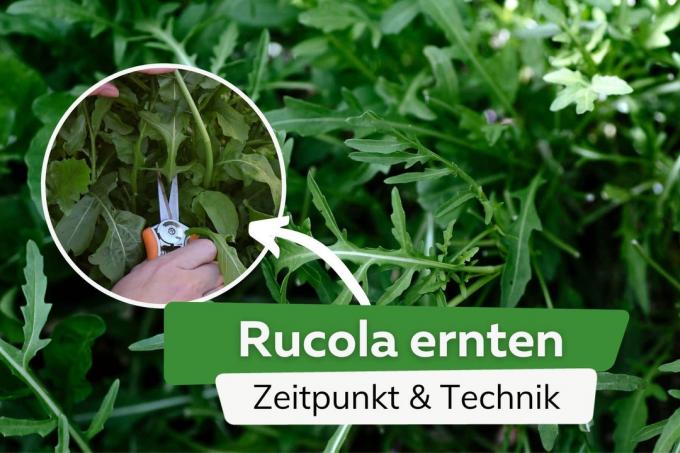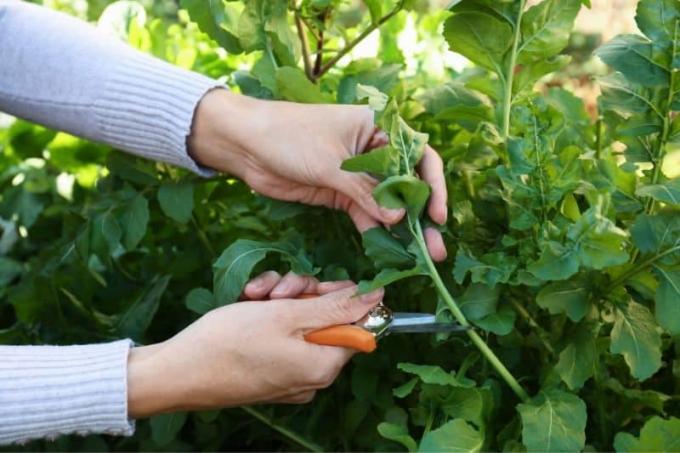
Arugula is a flavorful leafy green that requires harvesting at the right time. The guide explains when this is, which technique is used and what should be considered.
In a nutshell
- official harvest time in the garden and on the balcony between March and October
- Winter harvest possible
- more intense aroma with increasing size and leaf age
- Harvest flowers because they are edible
Table of contents
- Harvest time for leaves
- winter harvest
- blossoms
- harvest flowers
- right technique
- cut off
- pluck
- frequently asked Questions
Harvest time for leaves
There are two main types of arugula: the perennial wild rocket (Diplotaxis tenuifolia) and the annual, milder rocket salad (Eruca sativa). Both are cruciferous (Brassicaceae). They can be sown at the same time and, accordingly, harvested at a similar time.

In order to achieve an early harvest and thus a long harvest time, we recommend pre-cultivation indoors or in a warm greenhouse in February, especially for annual salad rocket. The first harvest can then be expected around seven weeks later in April. Sowing outdoors from April delays the first harvest until June.
If the temperatures rise from June, the harvest time is shortened and the rocket can already have leaves ready for harvest after three to four weeks.
The plants give a precise indication of the perfect harvest maturity:
- juicy green, dark green in wild rocket
- about 10 cm to 15 cm in leaf length for best aroma
- crisp but not too hard structure
- firm consistency indicates higher age of the leaves and bitter, pungent taste
winter harvest
When the blossoms of the last rocket plants wither in autumn, the harvest time is over. If you want to continue harvesting the rocket in winter, you can sow it again in the fall indoors or in a heated greenhouse. Here, too, it can take up to seven weeks for the fruit to be ready for harvest. However, the development in autumn sowing and consequently the aroma is weaker. Therefore, the perfect time to harvest is when the leaves have reached a height of 10 cm. In terms of color intensity, the leaves that are ready for harvest can be slightly lighter than the spring and summer seeds.
Tip: The leaves are particularly fresh and juicy if you harvest them on a sunny morning or in the early morning hours.
blossoms
The Arugula flowers between June and September, depending on the weather and site conditions. Once the first buds form, the plant structure and flavor of the leaves change. This usually only affects the older leaves. These become increasingly sharp with the beginning of flowering and slowly develop bitter substances. Immediately after flowering begins, the already ripe leaves can be harvested and processed as usual. But soon she worries bitter sharpness to the fact that older, fresh leaves are no longer edible. But they can be used dried for seasoning. For fresh consumption, only young leaves are to be harvested, which are significantly smaller than before the start of flowering.

harvest flowers
The blossoms of the arugula are also edible and should be harvested. They have a significantly milder spiciness than the leaves and have a subtle sweetness. As a result, they show a taste that is a little reminiscent of watercress and the rocket flowers can therefore be used in equal measure.
Tip: Arugula is self-seeding. Leave the inflorescences in place and allow the seeds inside to mature these into the ground from time to time and with a little luck new ones will develop from them next spring rocket plants.
right technique
There are two different techniques that can be used to harvest arugula leaves.
cut off
While cutting in bunches is often recommended, each leaf that is ready to be harvested should be cut off individually. This prevents unripe leaves from getting in between.

In addition, the following should be observed:
- use sharp knife or scissors
- Disinfect cutting tool before use
- Make a deep cut about 3 cm above the ground, starting above the heart leaf
- Do not damage the heart leaves to ensure new shoots
pluck
Plucking is a classic technique, especially for lettuce, but it can also be used with rocket.
How to proceed:
- select outer harvest-ready leaves for first harvest
- with further harvests, gradually pluck leaves up to the middle of the plant
- Grasp the stem about 3 cm above the ground with your thumb and forefinger
- Bend the stem outwards
- Heart leaves must remain undamaged
- avoid tearing the leaves
Tip: You should not fertilize your rocket plants, especially not with nitrogen. Although this drives leaf growth, it may also increase the harmful nitrate content.
frequently asked Questions
Leaf holes are usually caused by flea beetles, which prefer arugula as food. However, they only cause optical damage to the leaves. The leaves are safe to harvest and still edible, but like any vegetable, they should be washed thoroughly beforehand.
Freshly harvested arugula will keep for about two to three days in the cool vegetable compartment of the refrigerator. Wrapping it dry in damp cloths can add a day to its shelf life.
A sowing cycle of three weeks is recommended for a continuous harvest. This ensures that new plants quickly compensate for the loss after the flowers have wilted and growth has ended.

